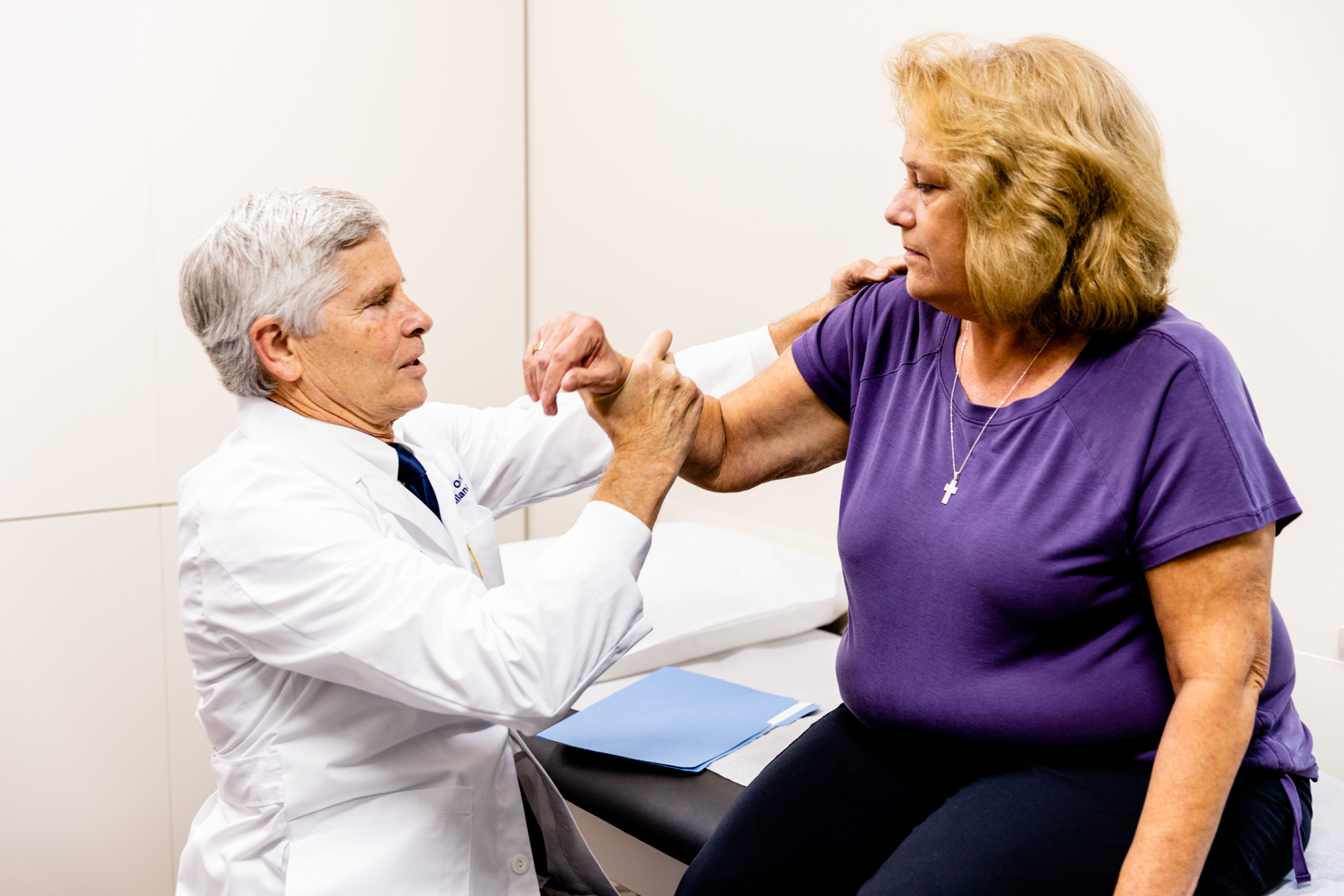
Shoulder pain can happen to anyone—and it often occurs when you least expect it. Whether you’ve suffered an acute injury or your shoulder pain has developed over time, it can prevent you from completing daily tasks, working your best, and sleeping comfortably.
If shoulder pain is affecting your daily activities, it’s crucial to seek treatment from a qualified orthopedic provider. In many cases, early treatment is the key to a successful recovery. If you delay evaluation and treatment, it can lead to further complications and a longer recovery process.
If you’re ready to live pain-free, the first step is to find an orthopedic clinic in Kansas City that can diagnose the cause of your pain.
Kansas City Orthopedic Alliance is the Midwest’s premier provider of orthopedic care. As the largest orthopedic practice in Kansas City, we treat thousands of patients each year across our 5 locations: Overland Park, Leawood, Belton, Kansas City, and Blue Springs. Using the latest technology, our physicians can evaluate, diagnose, and treat nearly any type of shoulder injury.
At KCOA, one of the most common reasons patients come to us with shoulder pain is due to rotator cuff injuries. In this blog, our orthopedic experts will discuss the common signs and symptoms that suggest you need rotator cuff treatment in Kansas City.
What Is the Rotator Cuff?
Before we can understand the rotator cuff and how it functions in our body, it’s important to have a general understanding of the shoulder and how it works.
Bones of the Shoulder
The shoulder is the most mobile joint in our bodies. It is made of two bones—the humerus and the scapula.
The humerus is the bone of your upper arm. At the top of this bone is a ball-shaped head that fits into the scapula. You might know the scapula as your shoulder blade. This flat, triangular-shaped bone has a shallow socket where the top of the humerus meets.
Together, these bones create a ball-and-socket joint that allows your arm to move in various directions.
The Rotator Cuff
The rotator cuff is a group of muscles and tendons that hold the ball and socket together. These muscles provide stability for the shoulder and allow it to rotate safely.
There are 4 muscles of the rotator cuff that help the shoulder move. They are the:
- Supraspinatus muscle
- Infraspinatus muscle
- Subscapularis muscle
- Teres minor muscle
While it isn’t necessary to dive into the intricacies of these muscles, it is important to know that damage or injury to any of these four muscles can cause pain and impair the function of your shoulder. Rotator cuff treatment in Kansas City can focus on the repair of any (or all) of these muscles.
Causes of Rotator Cuff Tears
There are two general reasons people tear their rotator cuffs—acute injuries and chronic age-related injuries (“degenerative tears”).
Acute Rotator Cuff Injuries
Acute injuries are those that happen suddenly. Acute rotator cuff tears can range in severity—you may experience immediate pain after the injury, or you may experience little to no pain at all.
Some of the most common acute injuries that can result in rotator cuff tears include:
- Falls
- Sports injuries (especially for sports that involve rapid overhead arm movements, such as baseball, tennis, basketball, football, lacrosse, and swimming)
- Lifting heavy objects without proper form
- Sudden, forceful arm movements during any activity that requires pushing, pulling, or jerking motions
Age-Related Rotator Cuff Tears
For patients in their upper 60s and beyond, rotator cuff tears are common because of the degeneration of fibers in the shoulder. These tears develop gradually over time due to the wear and tear on the muscles and tendons of the rotator cuff.
As we age, our tissues lose blood supply, making them more susceptible to injury. These vascular changes also make it more difficult for your body to heal the injury on its own. Rotator cuff tears caused by degeneration can range in severity, but patients often notice worsening pain as the tear progresses.
Symptoms of Rotator Cuff Tears
Rotator cuff tears can lead to a range of symptoms, depending on the type of tear and the extent of the injury. However, common symptoms we see in patients with rotator cuff tears usually include:
- Pain in the shoulder (that usually worsens with certain movements or activities)
- Muscle weakness in the shoulder and arm (making it difficult to lift objects or reach overhead)
- Reduced range of motion (such as difficulty raising or rotating the arm)
- Swelling and tenderness around the shoulder joint
Diagnosis
Diagnosing your injury is the first step to finding the right treatment for your pain. In many cases, shoulder injuries can be diagnosed with a history, physical exam, and X-rays. MRIs can be useful in some cases, but they aren’t always necessary, depending on your injury.
At KCOA, we consider the whole picture of your health when determining your diagnosis and treatment. If we suspect you have a rotator cuff tear that would heal with rehabilitation, we may recommend initially putting your time and money towards physical therapy treatment rather than a diagnostic MRI.
Our providers will work with you throughout the entire process to ensure an accurate diagnosis and effective rotator cuff treatment in Kansas City.
Other Shoulder Injuries
There are several shoulder injuries that can be mistaken for rotator cuff tears. Some of the most common include:
Labral Tears
The labrum is a ring of cartilage that lines and reinforces the shoulder joint. Connected to the socket of the shoulder, this cartilage acts as a shock absorber and plays a crucial role in stabilizing the shoulder.
Labral tears can happen during a dislocation, repetitive overhead arm movements, or carrying heavy objects. Common symptoms of a labral tear include:
- Pain in the shoulder
- A catching or locking feeling in the shoulder
- Weakness
- Instability
- Limited range of motion
Related: Torn Labrum Treatment in Kansas City
Biceps Tendonitis
Biceps tendonitis is a condition characterized by inflammation of the biceps tendon. This strong, cord-like structure connects the biceps muscles to the bones of the shoulder. When this tendon becomes irritated, it can cause weakness, tenderness, limited movement, and pain in the front of the shoulder.
Treatments for biceps tendonitis usually involve rest, ice, medications, pain injections, and physical therapy. Learn more about tendonitis treatment in Kansas City →
Rotator Cuff Tendonitis
The tendons of the rotator cuff are also subject to inflammation and irritation. This often occurs as a result of repetitive shoulder movements (such as overhead sports motions), age-related changes, poor posture, or an acute injury.

Rotator cuff tendonitis can mimic the symptoms of a rotator cuff tear, including:
- Shoulder pain
- Weakness
- Tenderness
- Pain at night
- Limited range of motion
Because so many shoulder injuries can lead to similar symptoms, it’s crucial to seek treatment from an orthopedic expert who can accurately diagnose your condition.
Treatments for Rotator Cuff Tears
For most patients with rotator cuff tears, we start with conservative, nonsurgical treatments to relieve pain and improve function. This can include one or more of the following treatments:
- Rest and ice
- Activity modification
- Physical therapy
- Anti-inflammatory medications
- Corticosteroid injections
If we’ve exhausted all nonsurgical treatment options and you’re still having pain, it might be time to consider surgical treatment options. At KCOA, our surgeons typically use one of three approaches to surgical treatment:
Arthroscopic Repair
Arthroscopic rotator cuff repair is a minimally invasive procedure used to fix rotator cuff damage. The surgeon makes small incisions in the shoulder and inserts a camera to see inside the joint. With special instruments, the surgeon stitches the rotator cuff back together, guided by the camera. The vast majority of rotator cuff repairs are performed arthroscopically.
Open Repair
Open rotator cuff repair involves a larger incision to expose the torn rotator cuff. This allows the surgeon to directly visualize the injury and stitch it back together. In some cases, surgeons can address additional shoulder issues during this procedure.
Reverse Total Shoulder Replacement
A reverse total shoulder replacement is a specialized procedure sometimes used for very severe rotator cuff tears in older patients. This procedure changes the mechanics of your shoulder, making the rotator cuff unnecessary for range of motion.
Recovering From Surgery
When recovering from any shoulder surgery, you can expect the process to take months. You will spend a significant amount of time in a sling or shoulder immobilizer, followed by physical therapy to reactivate your muscles and get back your range of motion.
Recovering from shoulder surgery is a difficult process, but your KCOA provider will help prepare you for the journey ahead.
Visit KCOA for Rotator Cuff Treatment in Kansas City
At Kansas City Orthopedic Alliance, we’re dedicated to creating a superior patient experience for all. If you’re wondering what to do about shoulder pain, KCOA has skilled providers throughout Kansas City who can help.
We’ve helped thousands of patients treat their pain, restore their function, and improve their quality of life.
For a thorough evaluation, call us at (913) 319-7600 or schedule an appointment today. If you’re struggling with shoulder pain but don’t know where to start, use our symptom tracker for treatment recommendations.


